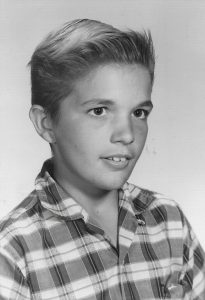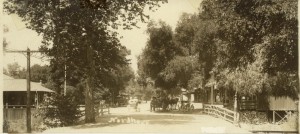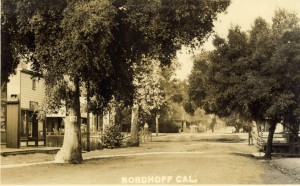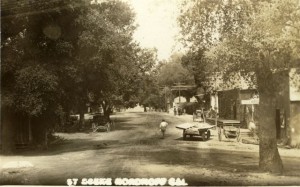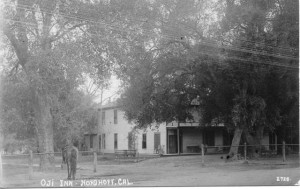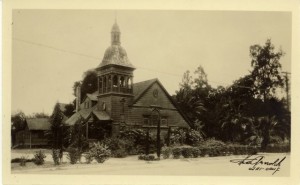The following article first appeared in the Wednesday, November 1, 1967 edition of “The Ojai Valley News and Oaks Gazette” on Page D-6. That newspaper is now the “Ojai Valley News”. The article is reprinted here with their permission. PLEASE NOTE: Nick Robertson wrote the article when he was only a Senior in high school. The photo of Robertson was added by the “Ojai Valley Museum”.
Less talk about hippies; more talk about change
by Nick Robertson
Happy Valley Senior
A “church in change” is a phrase which might draw a strong reaction from both those who think it is perfected and those who think it incapable of facing change. But to a majority of people, it is probably one of the greatest blessings to come from the institutionalized church for a long time.
There are many, myself included, that think that a religious and moral institution should lead the way for social reform, not fight it. There are, of course, arguments which slow the more impatient of us down to a walk: namely, that the church should consider social change carefully before either opposing or supporting it.
What an institution cannot afford to do is avoid facing social changes, and with this in mind, the United Presbyterian Church of So. Calif. sponsored a conference on Theonetics (a catchy, expressive and convenient if undenfinable word) with the subject “Under 21 in California.”
Aside from the word, which sounds much more active than theology, the subject is particularly attractive to someone under 21 in California. It was, as a matter of fact, even more attractive when I found I could be subsidized by the conference if I went as a “conversation starter”: one of the few times I have ever heard the axiom that children should be seen and not heard put to better disuse.
The idea of having a host of youths at the conference was necessary, not only because of the topic, but because over half of the speakers were well over 21 anyway (it was decided that 21 really meant nothing and it was youth that was being discussed). The formal parts of the meeting tended to be discussing youths rather than discussing with them.
As I have an admitted bias to being discussed rather than heard from, I think that I will speak primarily about being heard from.
Hippy topic
The hippies, whoever they may be at the moment, were the predominant topic of discussion for the first two days. It seemed to me that most of the people attending were unduly hung up on long hair and acid, and the program scheduled two speakers on the hippies. The first was the editor of a Los Angeles underground newspaper, “The Oracle”, and in keeping with the spirit of the times, he was well over 40. The second speaker did not show up for some reason, and by the second day it struck me as good luck that the emphasis (we youths had discussed threatening a walk-out unless emphasis was taken from the hippies) was shifted.
The first evening featured three young speakers under the heading of “Youth in Action”. They were all participants in some sort of social welfare program (Inner City, VISTA, and a function of the Presbyterian church called Caravaning). The church establishment came under a certain amount of fire from all of them, as the church is bound to. The message: do something!
I think that as far as I was concerned the most impressive speaker of the entire affair was introduced as “The Minority Youth.” He was Johnny Scott, a product of Budd Schulberg’s writer’s studio in Watts, and one of the most eloquent voices to come out of the ghetto (some of his poems appeared in both the L.A. Times and Time Magazine). Scott, a student at Stanford, spoke stirringly about the plight of the black man in a lily-white America. Being predisposed to such talks, anyway, for I feel that most of us WASPS (White-Anglo-Saxon-Protestants) have created a lot of our own problems, and having the guilty conscience of the typical white liberal, I don’t think anyone left the conference not duly impressed and saddened by the demand, not plea, for understanding of a black youth.
More discussion
The entire set-up of such an event makes it possible for all in attendance to either take or leave the insights presented as well as enrich them by informal conversations. It is only fair to admit that I approached the hall with somewhat the attitude of an extremely angry (and extremely) young man, and I think that hard-headed , angry revolutionists pale after a brief exposure. Were it mine, I would keep more time unstructured: I felt that the talks provided a tremendous stimulus, but a stimulus that could have been matured better by more freewheeling discussion. Our table talks were probably as important to all involved as any other single part of the conference, though I could have relaxed a little more at them.
One decided hang-up most young people attended with was the idea of communicating for result. We are an impatient breed. While we speak of the necessity of communication rather incessantly, there is, so to speak, method to our madness. Most went not with the idea of learning so much as to prod, to force a confrontation on the church, speed up a committee or two, and get what many young people in the church feel is a necessary involvement out of their congregation.
While adolescents are almost by definition a state of change, the church has often been a leader in social reaction, and it seems that there is now a tremendous impatience within the younger membership of the church that now demands action and acceptance of change.
But when one can obtain enough objectivity, it is seen to be a creative, worthwhile, and effective means of dealing with a problem (assuming that a younger generation is a problem). Perhaps we can attribute the tremendous concern for the younger generation to the long-haired, barefoot element. We beat the “seen but not heard” axiom by looking fully as obnoxious as we sound.
